This blog first appeared as an article in Shooting Times and Country magazine. It has been amended to provide more web links.
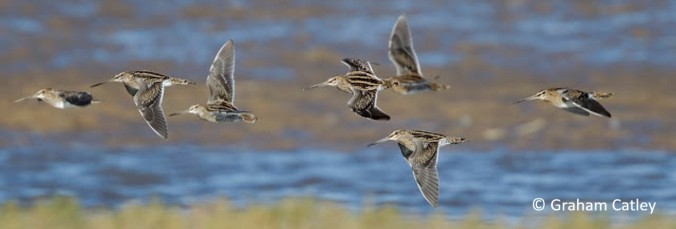
A wisp of Common Snipe
There’s a big difference between the number of Common Snipe and Jack Snipe we see in the United Kingdom each winter, with an estimated 1,100,000 of the former and 110,000 of the latter, according to the authors of Population Estimates of Bird in Great Britain and the United Kingdom. They remind us that Jack Snipe are hard to find and identify and warn that the total of 110,000 is a contender for ‘least reliable’ of the hundreds that have been compiled for this mammoth stock-take.
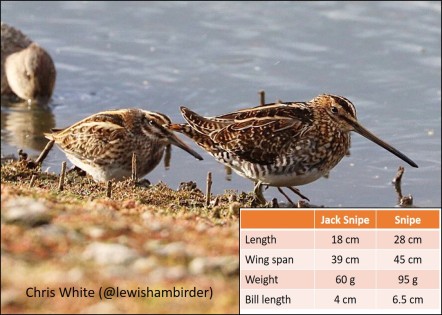 In theory, therefore, for every ten Common Snipe we see we ought to see one Jack Snipe. Telling them apart is mostly a matter of size (see table) and there’s a useful identification video that has been produced by the British Trust for Ornithology. Both species make good use of their striped, cryptic plumage to avoid detection but Jack Snipe take the art to the next level, hiding against or under a tussock until the last possible moment and then exploding from beneath a person’s feet. Given the closeness of approach, perhaps Jack Snipes might be more obvious and their numbers exaggerated?
In theory, therefore, for every ten Common Snipe we see we ought to see one Jack Snipe. Telling them apart is mostly a matter of size (see table) and there’s a useful identification video that has been produced by the British Trust for Ornithology. Both species make good use of their striped, cryptic plumage to avoid detection but Jack Snipe take the art to the next level, hiding against or under a tussock until the last possible moment and then exploding from beneath a person’s feet. Given the closeness of approach, perhaps Jack Snipes might be more obvious and their numbers exaggerated?
Jack Snipe
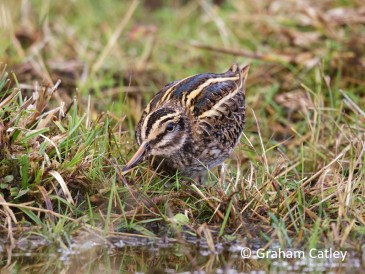
Jack Snipe probing in mud
In the winter months, Jack Snipe are not as closely associated with wetlands as are Common Snipe, preferring longer vegetation, such as that to be found in muddy, cow-poached rough grazing marsh, to the open edges of larger bodies of water. For the tiny Jack Snipe, a cow’s hoof-print forms an ideal pool in which to probe. One of the areas that birdwatchers go to see Jack Snipe is Glasgow. Strange though it may seem, several of the wetland areas within the city limits hold small numbers of birds, especially in autumn, when migrating Jack Snipe pass through Britain, on their way from Scandinavia to wintering areas in south-west Europe. Members of the local ringing group have focused a lot of effort on this species, catching individuals by dragging a mist-net through the rough, wet, reedy grassland and ringing birds that have jumped from the ground as the net passed over them. See blog by Gillian Dinsmore.
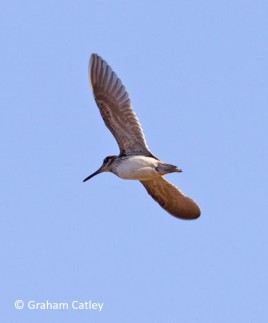
Jack Snipe are relatively long-winged
Jack Snipe are well designed for migration, with much bigger wings for the size of the body than the Snipe. Unlike Common Snipe, many of which migrate in flocks, or wisps, Jack Snipe are thought to travel mostly alone and at night. They cover long distances, with some birds from Russia crossing the Sahara and those from eastern areas of Siberia travelling to eastern Africa, India and southern coastal countries of mainland Asia. The birds that winter in the British Isles have much less far to travel than the majority of the population, therefore.
Wintering Common Snipe
Common Snipe, which are much bigger and more common than Jack Snipe, start to appear in their wintering areas as early as August. The pioneering birds are juveniles; most adults moulting at least some of their flight feathers before flying south and west in September and October. We know this because many French hunters have provided wings to scientists studying the age and sex structure of the population in that country. Moulting is an energetically expensive part of any bird’s life, so autumn feeding conditions are presumably generally good enough for moult to have been at least started, if not finished, before birds leave the breeding areas. Not every bird manages to fit in a full moult before it’s time to move south, however, with one in six adults shot in France found to be in suspended moult, having shed and moulted some primary feathers before migration, with a view to completion in the wintering grounds. A slightly smaller number have a mixed age of secondary flight feathers and about a quarter delay completion of covert moult.
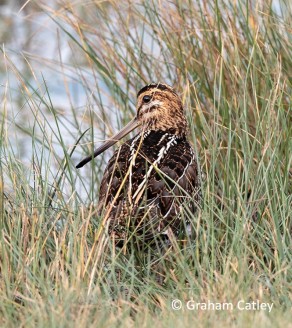
Common Snipe
Although most of the Common Snipe we see in Britain in the wintertime have come from Scandinavia and mainland Europe, Ireland has a strong additional connection to Iceland. A quarter of foreign-ringed Common Snipe discovered in Ireland or Northern Ireland have been found to be wearing Icelandic rings, compared to 1 out of 255 in England, none in Wales and just 10% in Scotland. This and lots of other fascinating facts about migration come to light because hunters kindly send information about ringed birds to The British Trust for Ornithology, which is ‘mission control’ for ringing in both the UK and Ireland. This information is available on-line via the BTO website.
Across Europe, although there is almost certainly a decline in the number of Common Snipe, probably linked to man’s incessant drive to drain wetlands, there is no suggestion as yet that Common Snipe should be added to the list of species of conservation concern.
Snipe breeding in Britain & Ireland
British and Irish Snipe are in trouble. By the time of the first national bird surveys, some 50 years ago, we had been turning wetlands into farmland for as much as 2000 years and, since then, numbers of Common Snipe may well have fallen by a further 90% in the areas in which they are still breeding. There has been a major shrinkage of the species’ range since 1968-72. Losses are shown as downward triangles in the map from the latest Bird Atlas, published by the British Trust for Ornithology. The rate of decline across England, Wales, southern Scotland and much of Ireland in the shorter period since 1988-91 emphasises just how quickly the species is being lost. It can only be a matter of time until Common Snipe is added to the red list of species of conservation concern in the UK, in order to highlight the perilous plight of our breeding population.
Update: although we have lost large number of Snipe over centuries, the latest figures from the Breeding Bird Survey indicate a 26% increase between 1995 and 2018. The species is still thinly spread and the confidence interval associated with this 26% estimate is large – somewhere between 4% and 55%.

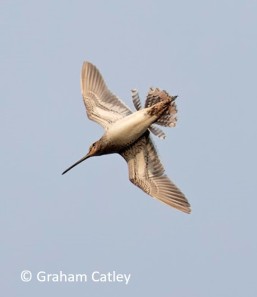
Displaying Common Snipe
A displaying Common Snipe is a magical thing – flying around with real purpose, climbing into the sky and vibrating its tail feathers in a stooping descent. Our grandparents could have heard them drumming on grazing marshes anywhere in the country and just imagine what the fens of eastern England must have been like 500 years ago. These days, most people in southern Britain will have to visit a nature reserve even to have a chance to share that same magic. I am lucky enough to go to Iceland every summer, where I can still easily see a dozen Common Snipe displaying at the same time above areas of wet grassland. If you want anything like the same sort of experience in the UK, you’ll probably need to travel to the Outer Hebrides.
WaderTales blogs are written by Graham Appleton, to celebrate waders and wader research. Many of the articles are based on previously published papers, with the aim of making wader science available to a broader audience.

Reading the orginal BB paper I thought at the time the population estimates for both Snipe species were likely to be exaggerated and particularly so for the proportion of Jacks to commons, I only wish I had seen one Jack for every ten Snipe! I’ve yet to see Jack Snipe in my own parish despite some promising habitat (and 25 years of looking!). It is also scarce enough as a species that most birds seen are reported and looking through bird reports for areas I am interested in most only contain a handful of sightings.
LikeLike
Pingback: WaderTales: a taste of Scotland | wadertales
Pingback: Wales: a special place for waders | wadertales
Pingback: 10,000 Birds | Common Snipe
Pingback: Flyway from Ireland to Iceland | wadertales
Pingback: Which wader, when and why? | wadertales
Pingback: Scottish wader woes | wadertales
I have noticed from watching several colliery tips around Doncaster and Pontefract that Jack Snipe seem to have an affinity with these sites, favouring damp patches. However, I have also noticed that even within these areas they favour some areas rather than others despite there appearing little or no difference in the habitat. It would be interesting to know if the concentration of records in Glasgow is on former industrial sites.
LikeLike
Pingback: The waders of Northern Ireland | wadertales
Pingback: Do population estimates matter? | wadertales
Pingback: Migration blogs on WaderTales | wadertales
Pingback: Fennoscandian wader factory | wadertales
Pingback: Coming soon | wadertales
Pingback: The First Five Years | wadertales
This year were I live in the northwest of Ireland,I’ve seen more small flocks of common snipe than I’ve seen in many years, would this mean that they’ve had a good breeding year?
LikeLike
It depends upon when you saw them. Early autumn flocks of juveniles is a good thing.
LikeLike
I know that the breeding range of G. g. faroeenis is described as Iceland, the Faroes, Orkney and Shetland but I wonder is it possible that they may breed in Britain and especially Ireland also, or are all our breeding birds G. g. gallinago? Also, do you know if our breeding birds all migrate, or do some remain in the same area all year? I have been looking into recent records of breeding snipe in northwest Ireland and it seems lowland wet grasslands can hold snipe at fairly high densities in small areas, whereas upland snipe are thinly scattered across large areas, though the latter that may be largely due to a lack of data. Great article as always.
LikeLike
I share your scepticism about the hard boundaries between areas that are purported to be home to different subspecies. Snipe are tough to study and I can’t think who would be able to answer your questions, I’m afraid.
LikeLike
Thanks for the quick reply. Still a lot we don’t know I guess, especially about secretive species like snipe.
LikeLike